The Arab Israeli Vote in the 23rd Knesset Elections
The people had their say in these elections. A majority of the Arab Israeli public (65%) turned out to proclaim a resounding vote of confidence in the Joint List

Flash 90
The elections for the 23rd Knesset brought with them an unprecedented success for the Joint List, as it won 15 seats in the Knesset—the largest number of seats ever won by Arab parties in Israel’s national elections. Moreover, the Joint List also attained historical firsts in several other respects. This was the first time a woman was elected to the Knesset from all of the four parties that make up the Joint List: in total, four Arab women were elected, comprising 27% of the Joint List’s Knesset members. The List is also the Knesset faction with the greatest diversity among its members: ten Muslims, three Christians, one Druze, and one Jew.
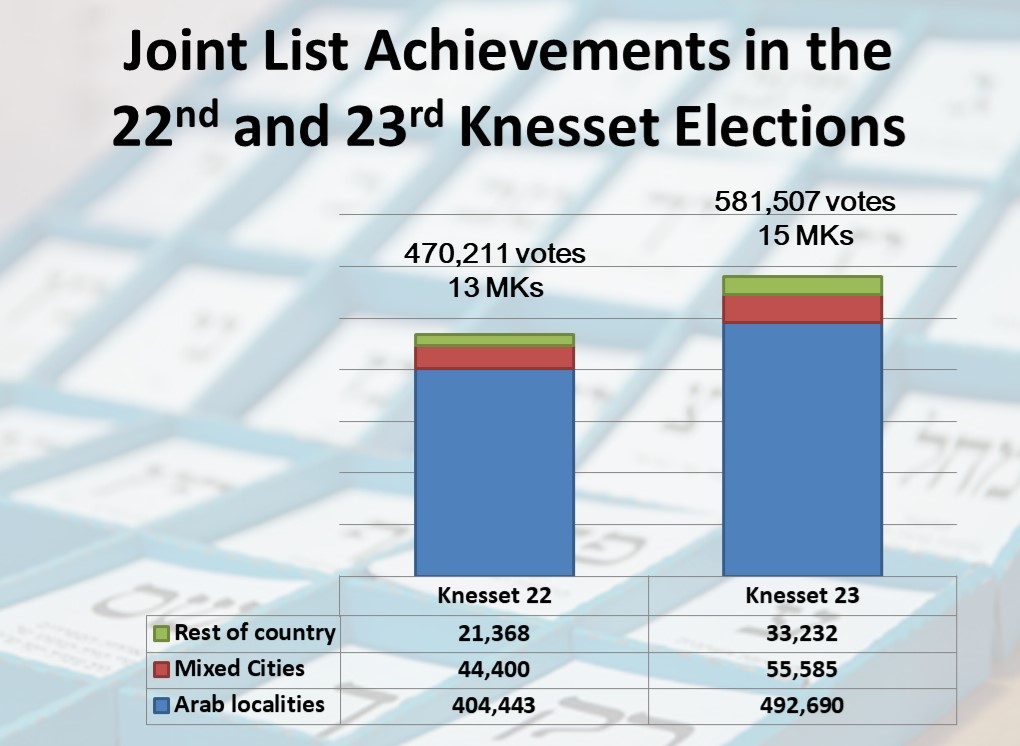
These historical milestones were achieved thanks to a dramatic rise in voter turnout in Arab towns and cities, which reached its highest level of the last two decades—64.8%-even higher than the turnout in the elections to the 20th Knesset (63.4%), when the Joint List was first formed. Another notable result highlighting the unprecedented achievement of the Joint List in these elections, was the number of votes it received outside of Arab towns and cities, yielding it more than two Knesset seats. In these elections, among the total number of Joint List votes, the proportion of those from mixed cities and with other locales was the highest ever: (15.3%), even higher than in the elections to the 22nd Knesset (14.0%) and the 20th Knesset (13.2%) when the Joint List was formed.

Northern Israel
In large cities in the Galilee (those with at least 10,000 voters), which constitute the mainstream of the Arab body politic in Israel, average voter turnout reached almost 69%, and the average level of support for the Joint List was 94%. While in Nazareth, the largest Arab city in Israel (home to around 58,000 voters), voter turnout was only 60% (compared with 55% in the September 2019 elections), in Shefar’am, the second-largest city in the Galilee (with around 29,000 voters), turnout was 66%. In Tamra and Sakhnin, two of the largest cities in the Galilee (each with more than 20,000 voters), voter turnout reached almost 80%. The highest level of voter turnout was recorded in Deir al-Asad and Kabul (each with some 8,000 voters), at 83.8% and 82.5% respectively.
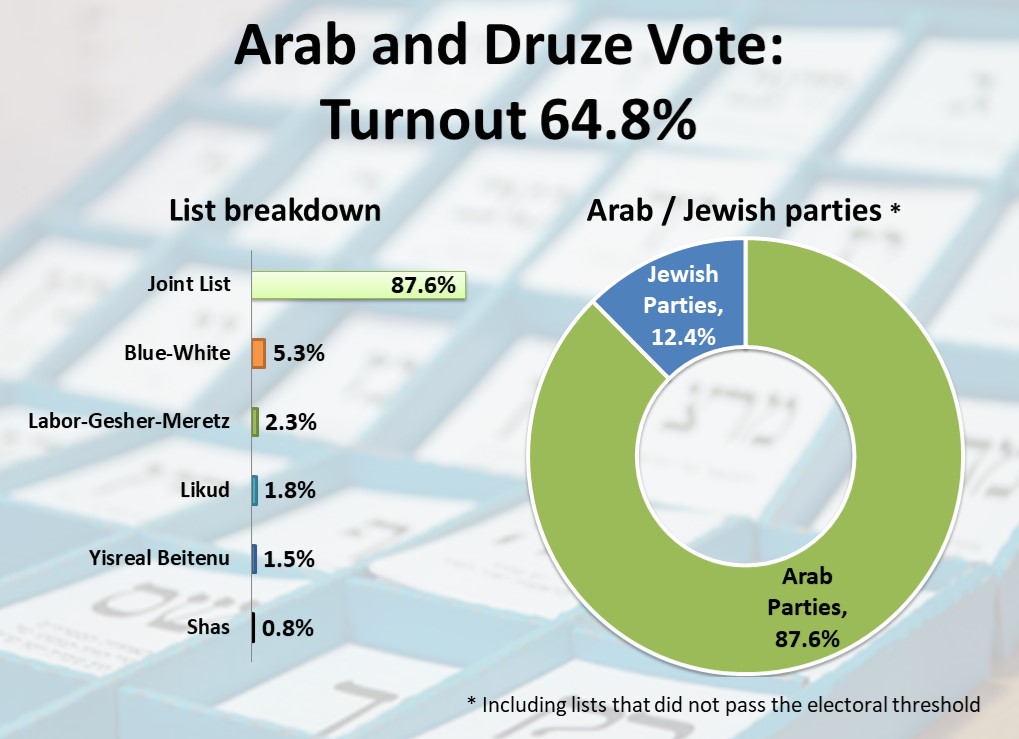
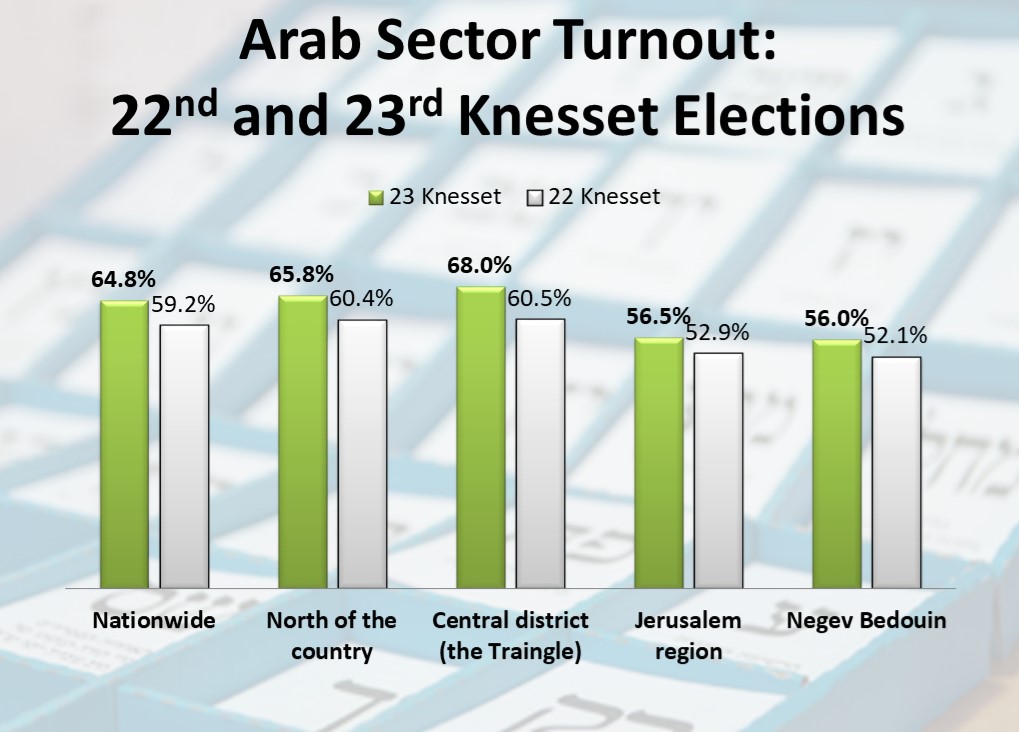
Not only was voter turnout particularly high, but support for the Joint List also rose significantly as compared with the September 2019 elections. This increase was evident across all the Arab population groups in northern Israel, including Bedouin, Christians, and even Druze.
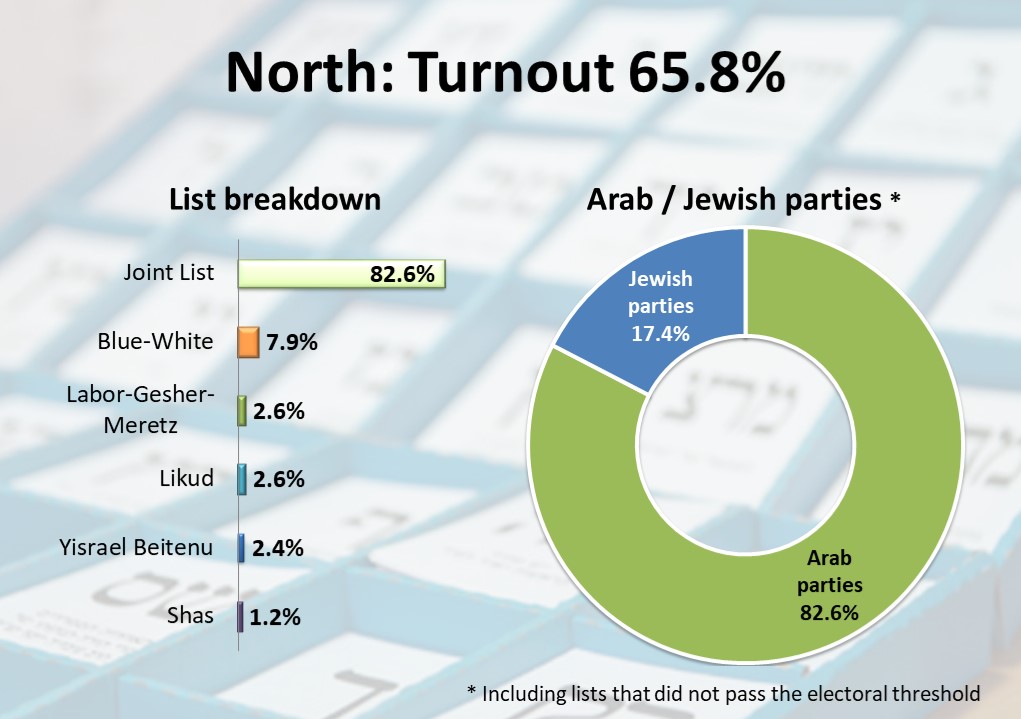
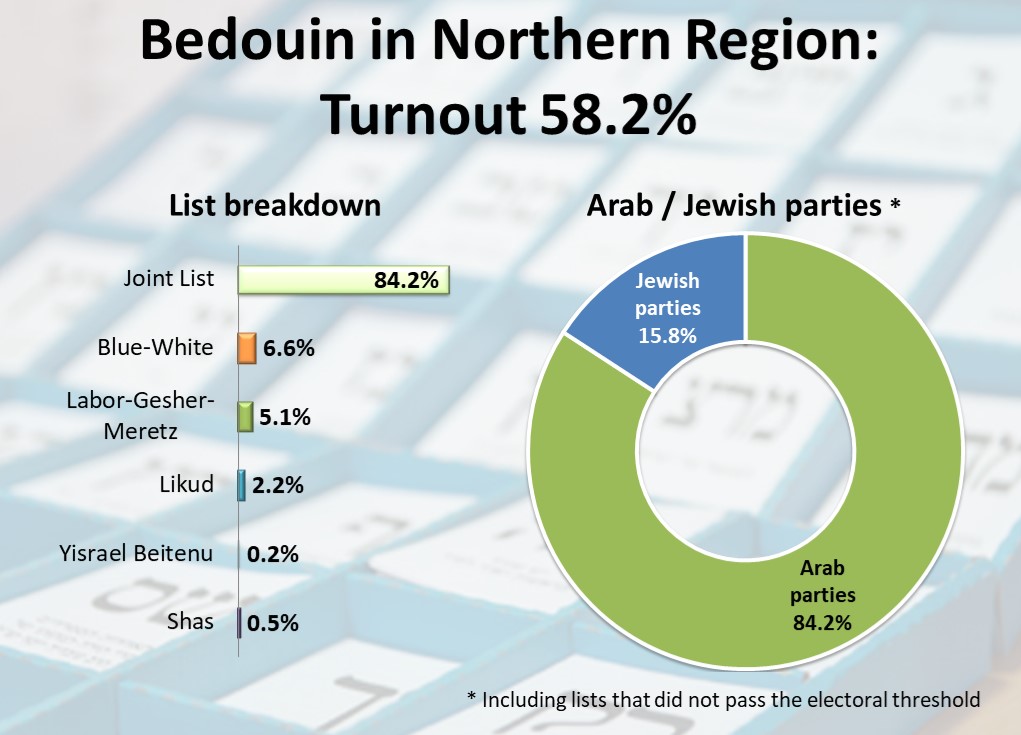
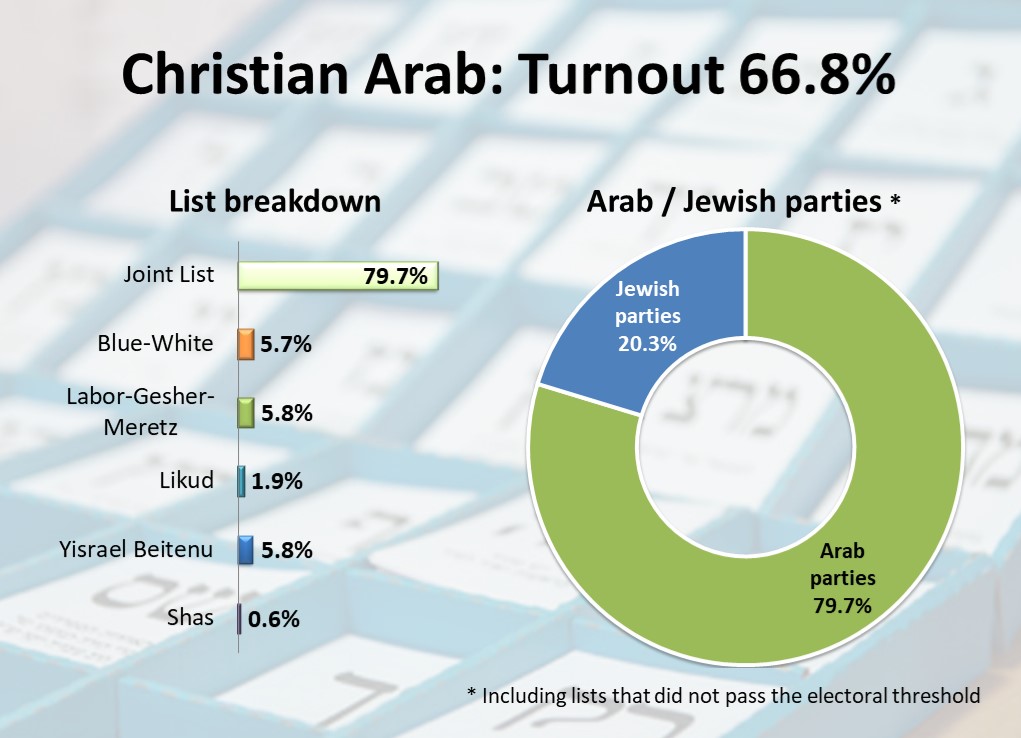
The significant rise in voter turnout was found in all Arab localities in Israel, with the exception of Druze towns and cities. A comparative examination of Druze voter turnout in the last three elections reveals that the changes seen in Arab politics have not affected voting patterns and voter turnout in the Druze electorate. In the elections for the 21st Knesset, held in April 2019, at which voter turnout in the Arab public reached an all-time low (49.2%), voter turnout in Druze localities in the Galilee was 56.6%. In the elections for the 22nd Knesset (in September 2019), when voter turnout in the Arab public rose significantly (to 59.2%) following the establishment of the Joint List, turnout among Druze voters dropped slightly to 53.9%. In the most recent elections (23rd Knesset), Druze voter turnout stood at 56.2%, similar to the level recorded in April 2019.
However, it is striking that the support among Druze voters for the Joint List in these elections (21.1%) was almost double than in the April 2019 elections (11.4%). The stable level of voter turnout among the Druze electorate in the last three elections, alongside the increase in votes for the Arab parties represented by the Joint List, indicates a rise in support for Arab parties among Druze voters, at the expense of their traditional support for Jewish parties.
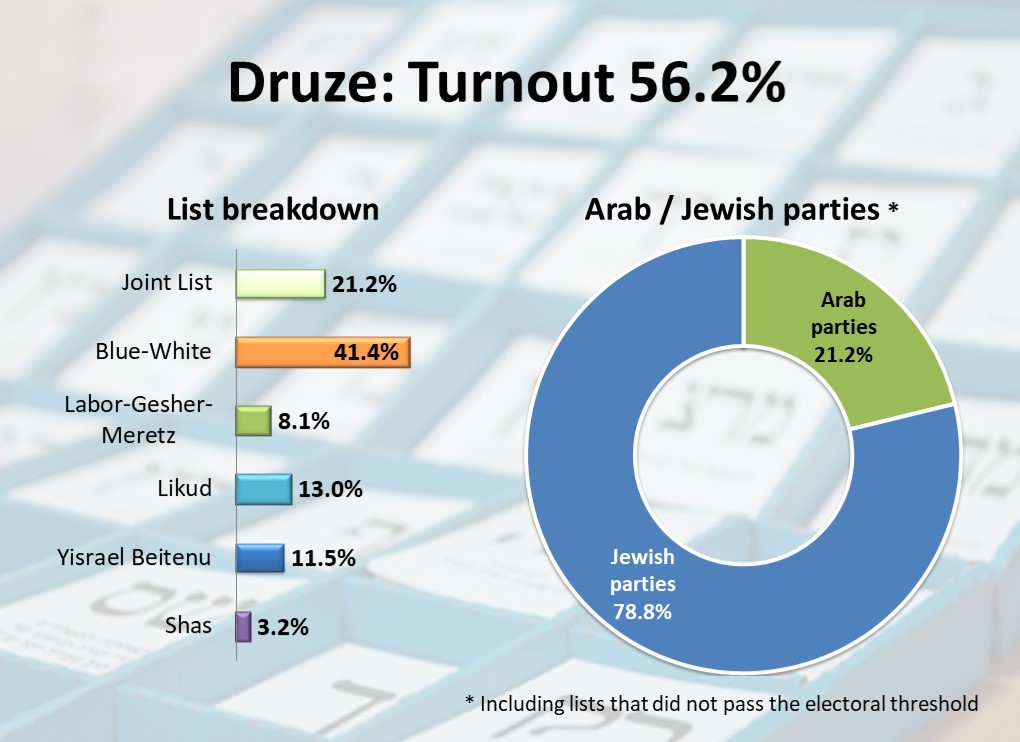
Triangle Region
The question of how residents of the Triangle region would vote attracted a fair amount of attention in the lead-up to the elections. This was due to the possible impact on voter turnout with regard to the “deal of the century” plan, announced some six weeks before the election, and specifically-- in light of the plan’s controversial proposal to consider the annexation of some towns and cities in the Triangle to a future Palestinian state. The Arab response to the “deal of the century” was unequivocal: voter turnout in the Triangle region was particularly high.
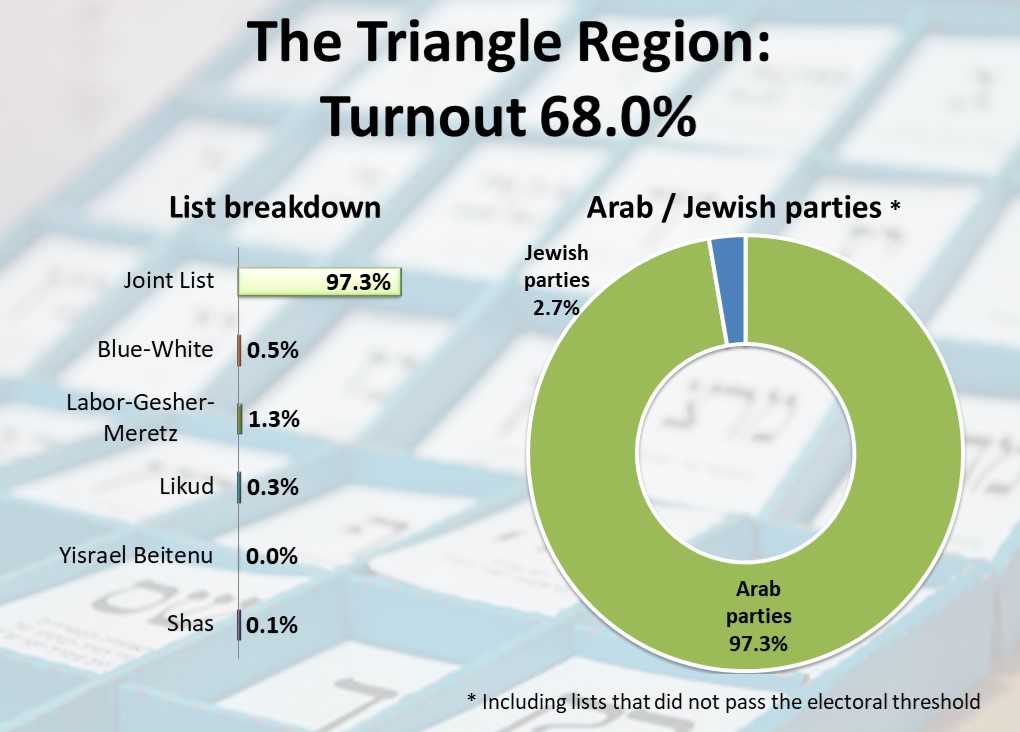
Average overall voter turnout in the Triangle region (68%) was similar to the average voter turnout in the large urban centers in the Galilee. The highest level of voter turnout was recorded in the southern Triangle region (72.9%), as a result of particularly high voter turnout in the large municipalities of Taibeh (70.9%), Kfar Kassem (73.9%), and Qalansuwa (72.6%). In the large municipalities in the northern Triangle region, high voter turnout was recorded in Kfar Kara (71.9%), Ar’ara (68.6%), and Umm el-Fahm (63.1%). The wall-to-wall support for the Joint List among Triangle residents was particularly striking, at 97.3%.
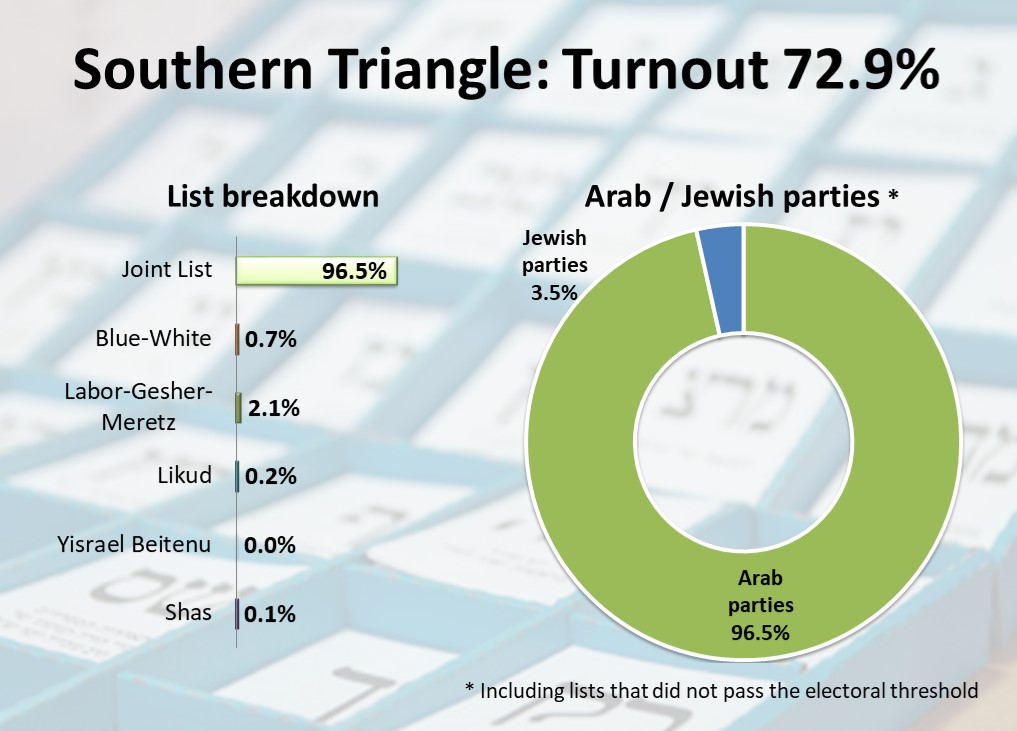
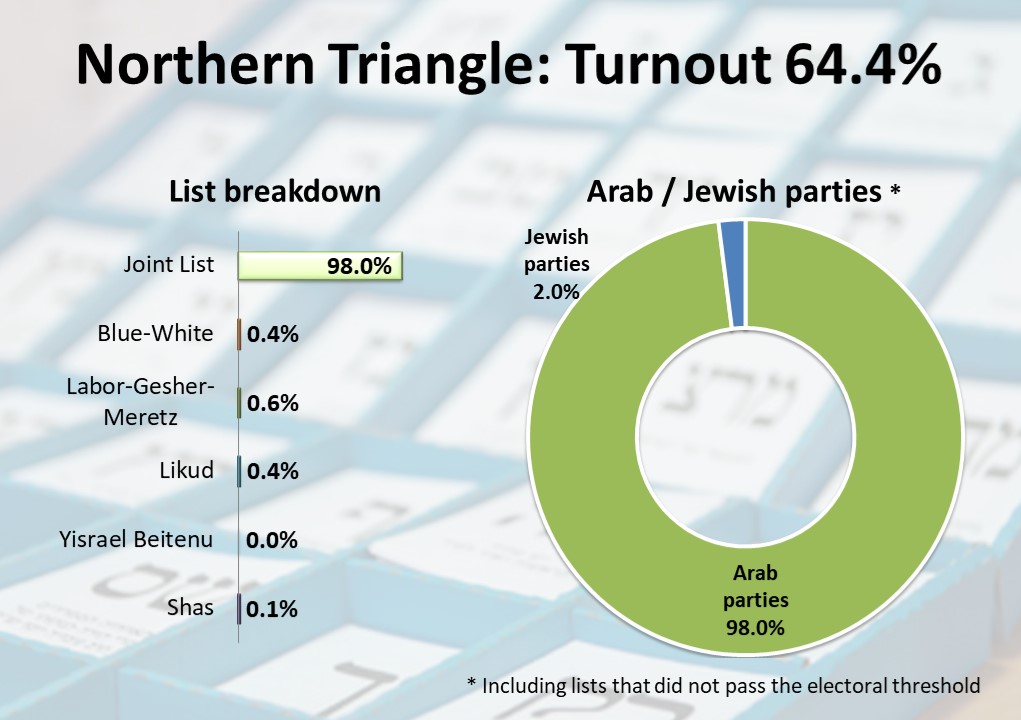
Jerusalem Region
The data on Arab turnout in the Jerusalem area refers to three small villages located in the Jerusalem corridor, with some 7,000 voters. The biggest and most well-known is Abu Ghosh (about 4,800 voters). The turnout in these three villages in the last election (56.5%) was only slightly higher than in the September 2019 election 52.9%). However, there is a noticeable increase in support for the Joint List in the last election (82.1%) compared to the support it garnered in September (72.8%).
The Jewish parties have been in turmoil: the Likud has doubled its strength compared to the previous elections in September (from 3.8% to 7.8%), while Blue and White lost more than half of its strength (from 12.2% to 5.6%).
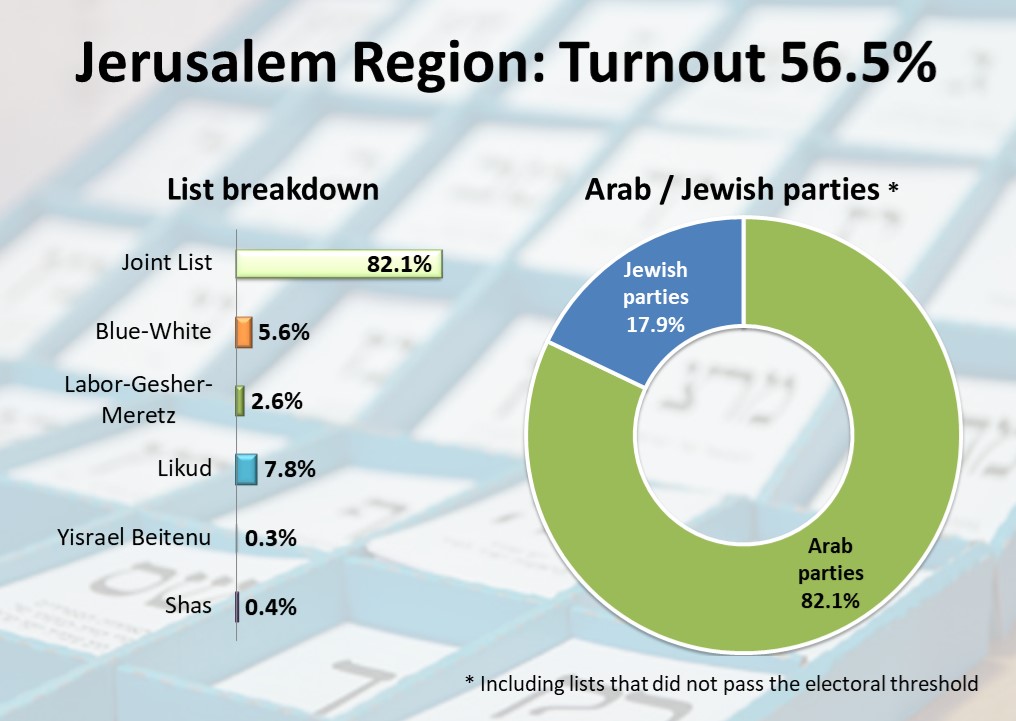
Bedouin in the Negev

A relatively low voter turnout (56.0%) was recorded among Bedouin in the Negev, though this continues a growing trend. Voter turnout of Negev Bedouin was 52.1% in the September 2019 elections, and just 47% in the 2015 elections, when the Joint List was first formed. In the recent elections, voter turnout in Bedouin towns and villages and in regional councils was over 60%. Only a relatively low voter turnout of Bedouin tribes (43.9%) - in themselves almost twice their voter turnout in April 2019 - prevented the Joint List from achieving more. It can be estimated that if members of tribes had voted at similar levels to the overall Bedouin population in the Negev, the Joint List would have won an additional 5,000 votes, and come close to winning a 16th Knesset seat. Ironically, the 16th candidate on the Joint List slate was Youssef Atawna, a resident of the Negev Bedouin town of Hura.


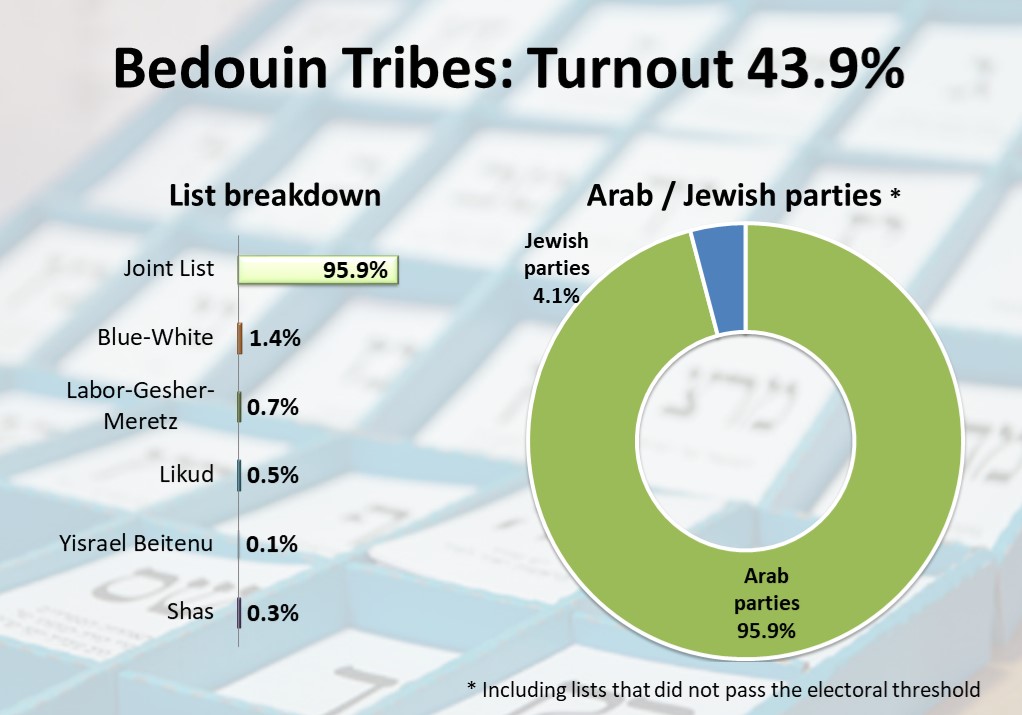
Mixed (Jewish-Arab) Cities
Voting patterns among Arab residents of mixed cities were analyzed based on a sample of voting stations meeting both of two conditions:
(1) This percentage of votes for the Joint List at the station was noticeably higher than the percentage of votes for the Joint List in the city as a whole, and
(2) Noticeably higher than the percentage of Arab residents in the city’s population.
The prevailing assumption is that the distribution of votes among Arab voters in mixed cities is similar to the distribution of votes among the Arab public as a whole, with the vast majority of votes going to the Joint List.
Analysis of the results from the voting stations meeting these criteria indicates that voter turnout among Arab residents in most mixed cities was close to the overall voter turnout in those cities, and even significantly exceeded it in two cities – Nof Hagalil and Ma’alot Tarshiha. In the cities of Lod and Ramla, in which voter turnout among Arab residents in previous elections was substantially lower than the overall municipal turnout, we can see a significant increase in Arab voter turnout.

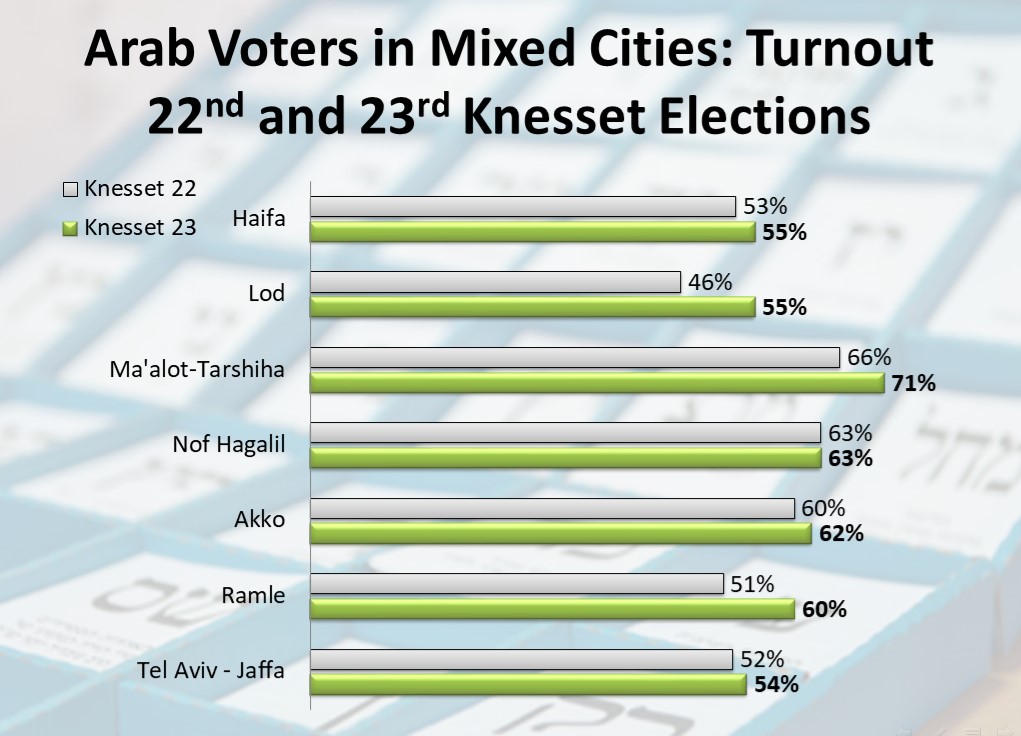
Arab Voting for Jewish Parties
The massive vote for the Joint List in Arab localities came at the expense of the vote for Jewish parties in these localities. Support for Jewish parties dropped to an all-time low. The party receiving the greatest support was Blue and White. However, unlike the September elections, when the number of Arabs casting their vote to Blue and White, was large enough to win Blue and White one Knesset seat, this time – the Arab support came in at less than one seat. The Labor-Gesher-Meretz ticket lost half of its support relative to the combined number of votes gained by its component parties in the previous elections. The only party to somewhat increase its support from Arab voters was the Likud, while Yisrael Beytenu and Shas suffered a slight decline.
However, unlike the September elections, when the number of Arabs casting their vote to Blue and White, was large enough to win Blue and White one Knesset seat, this time - the Arab support came in at less than one seat

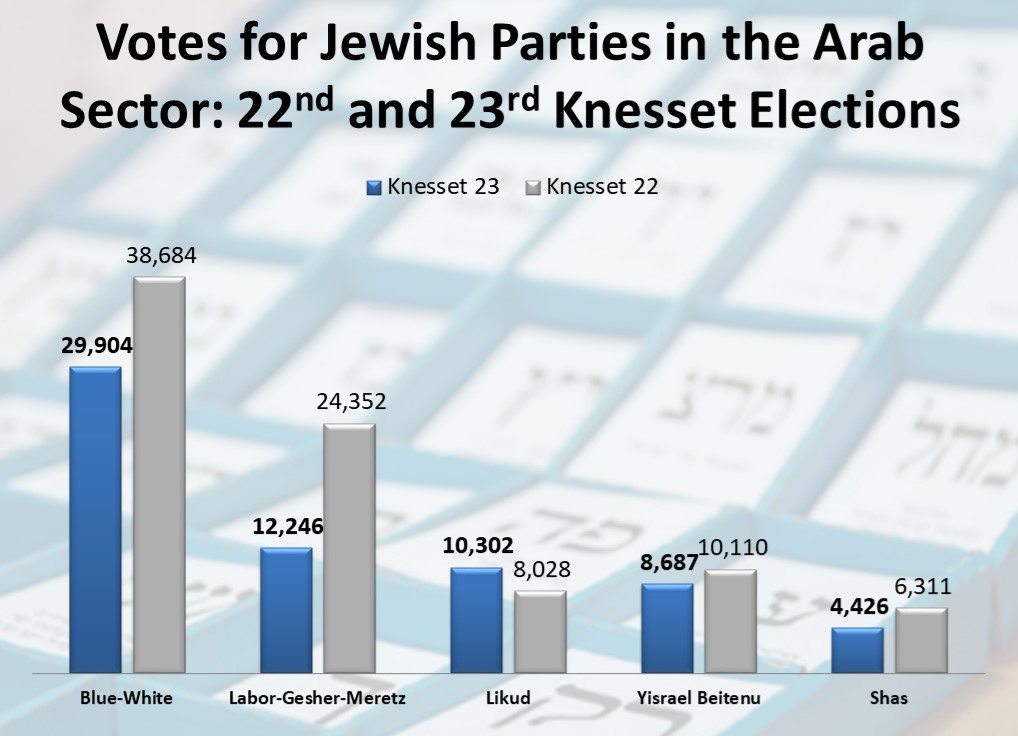
At the same time, it should be noted that in the recent elections, the percentage of “wasted” Arab votes—that is, votes for candidate lists that did not pass the electoral threshold—was the lowest on record, at just 0.5% (compared with 1.5% in 2015, 2.6% in April 2019, and 1.6% in September 2019). Contributing to this result was the fact that there were no other Arab lists on the ballot, apart from the Joint List. Thus, the main decision facing Arab voters in these elections was not which party to vote for, but simply whether or not to vote. Having decided to go to the ballot box, almost all Arab voters chose to vote for the Joint List.
Only three non-Jewish candidates from Jewish parties were elected to the Knesset , all of them Druze: Fateen Mulla (Likud), Gadeer Kamal-Mreeh (Blue and White), and Hamad Amar (Yisrael Beytenu). In total, 17 Arab and Druze Knesset members were elected, more than in any previous election.
Conclusion
The people had their say in these elections. A majority of the Arab public (65%) turned out to the polling stations to give a resounding vote of confidence to the Joint List. There have been three elections held in the last year, and naturally, public attention has been drawn away from the regular functioning of Knesset members in Israel’s parliament, and toward the election campaign and politicians’ wooing of voters. The Arab members of Knesset cannot rest too long on their laurels: the size of their accomplishment is matched by the extent of their constituents’ expectations. They must prove to the Arab public that the trust it placed in them, is justified. Achieving direct impact on government policy so as to address the burning issues on the Arab public agenda in Israel (violence, crime, employment, and housing and construction)—and in particular, enhancing the legitimacy of Arab citizens in Israeli public discourse—will serve to fortify the trust of the Arab public in the Knesset.
